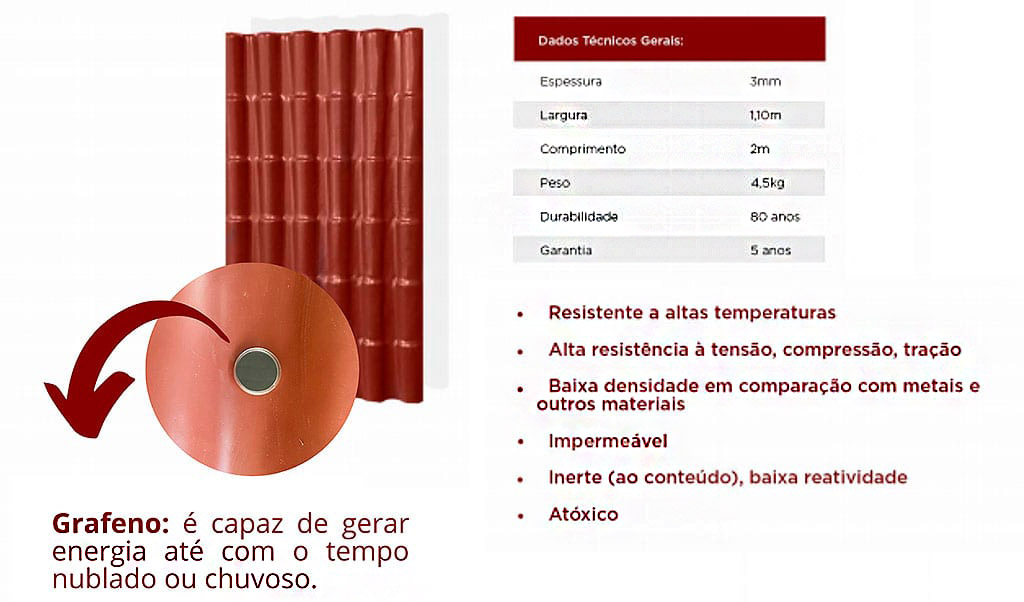
The company from Rio de Janeiro, Telite, has developed new solar tiles using graphene. Graphene tiles are capable of generating great savings on the electricity bill, and with only four units it is possible to meet the use of half of the consumption of a Brazilian residence
Telite, a company that operates in the interior of Rio de Janeiro, is proposing the recycling of plastic for the production of solar tiles. The company currently sells around 25 tiles a month and has recently launched a new product on the market: graphene that can generate solar energy. This tile can transform energy from the sun into electrical energy. Therefore, its construction becomes self-sufficient, generating great savings on the electricity bill.
With just four graphene tiles, a home can generate 30 kW

The solare tile is produced in high density polyethylene, being composed of graphene. It was through this material that the company managed to make 4 tiles able to generate 30 Kw per month in a medium-sized house.
According to the company, if the residence uses these four solar tiles, it will be able to become self-sufficient in the generation of electricity, generating a large savings on the electricity bill. However, if the number of graphene tiles in the house exceeds consumption and if there is electricity left over, it can be sold to the local electricity utility. The advantages are many, and the company even guarantees that its solar tiles can last for more than 70 years.
According to the manufacturer, graphene tiles, in addition to savings on the electricity bill, can last up to 80 years and are produced to serve a diverse audience. According to the company's CEO, Leonardo Retto, the company's objective was to create a technology capable of reaching all social classes, guaranteeing the possibility of taking renewable energy and sustainable way to places that still lack electricity in Brazil.
How are graphene solar tiles produced?
According to Telite, its graphene tiles are produced with HDPE, that is, a category of high-density polyethylene. HDPE is a polymer from the polyolefin family.
The thermal and mechanical structure of these tiles makes them more durable than ordinary ones. It is noteworthy that tiles are much easier to install.
It is important to highlight that graphene seems to be one of the most promising materials in the creation of new technologies in a wide range of industries. Invented in 2004, the material earned Konstantin Novosiol and Andrei Gejm the Nobel Prize in Physics. Its main characteristics are its lightness, rigidity, good electrical conductivity and impermeability.
Benefits of using solar tiles
The graphene tile, in addition to savings on the electricity bill, generates several benefits such as the production of clean and sustainable energy, the ability to generate energy self-sufficiency, durability, easy installation and maintenance, in addition to being an ecological tile accessible to all.
For the project to become viable, Telite faced several obstacles. One of them was to find a supplier of the graphene used in the composition of the new technology.
By finding a partner, the company raised around R$ 9 million for the tiles to be produced on a large scale. According to the company executive, Telite's concern right now is to ensure that a large production reaches the market. Until last year, the company had talked to graphene producers and, until then, there is no place capable of supplying the material on a large scale, given that the extraction of this material still has a high cost in the country.












Air Force F-16 fighters…
True friend, what they shot down were…
Air Force F-16 fighters…
I would like to know what planet you live on…
Air Force F-16 fighters…
Everything is fine, 100-year secrecy,…
Air Force F-16 fighters…
Well... It's flying scrap... Typical...
Air Force F-16 fighters…
Which genocide are you talking about? Than…
I want to introduce my country
I want to register
I have a 2019 Corolla and I'm going to change it...
Maybe, order a "snack" in China...
And I believe that anything that…
It will be another work with the seal…
I don't want to go at all...
I want to go to work in the Netherlands